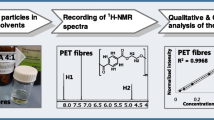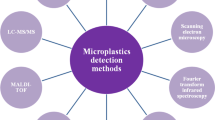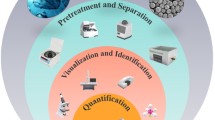Abstract
Micro- and nano-sized particles of polytetrafluoroethylene (PTFE) were used as model (reference) particles to study the biological effects of plastic pollution. Since the PTFE molecule contains fluorine, considered as an “atomic marker” sharply distinguishing it from other common plastics, micro- and nano-particles of PTFE have a specific crystalline structure and are, therefore, well identified by the methods of polarized light microscopy (POL), Raman microspectroscopy (micro-Raman), and energy-dispersive spectroscopy (EDS). Examples of PTFE particles detection in hemolimph of the cockroach Blatella germanica, in hemolimph of the larva and in faecal pellets of imago of a fly Lucilia sp., in the stomach and hingat of brine shrimp Artemia salina, and in association with cell wall of green unicellular alga Chlorococcus sp. are provided. The presented results strongly suggest that PTFE particles can be detected and identified in the biological medium using the method of “atomic markers”, polarization microscopy and Raman spectroscopy.








Similar content being viewed by others
Data availability
The datasets used and analyzed during the current study are available from the corresponding author on reasonable request. All data generated or analyzed during this study are included in this published article.
References
Al-Jaibachi R, Cuthbert RN, Callaghan A (2018) Up and away: ontogenic transference as a pathway for aerial dispersal of microplastics. Biol Lett 14:20180479. https://doi.org/10.1098/rsbl.2018.0479
Andrady AL (2017) The plastic in microplastics: A review. Mar Pollut Bull 119:12–22. https://doi.org/10.1016/j.marpolbul.2017.01.082
Andreassen E (1999) Infrared and Raman spectroscopy of polypropylene. In: Karger-Kocsis J (ed) Polypropylene. Kluwer Publishers, Dordrecht, pp 320–328. https://doi.org/10.1007/978-94-011-4421-6_46
Barboza LG, Vethaak AD, Lavorante BRBO, Lundebye AK, Guilhermino L (2018) Marine microplastic debris: An emerging issue for food security, food safety and human health. Mar Pollut Bull 133:336–348. https://doi.org/10.1016/j.marpolbul.2018.05.047
Bell WJ, Roth LM, Nalepa CA, Wilson EO (2007) Cockroaches: ecology, behavior, and natural history. Johns Hopkins University Press, Baltimore (Maryland)
Botterell ZLR, Beaumont N, Dorrington T, Steinke M, Thompson RC, Lindeque PK (2019) Bioavailability and effects of microplastics on marine zooplankton: A review Environ Pollut 245:98-110. https://doi.org/10.1016/j.envpol.2018.10.06
Browne MA, Dissanayake A, Galloway TS, Lowe DM, Thompson RC (2008) Ingested microscopic plastic translocates to the circulatory system of the mussel, Mytilus edulis (L.). Environ Sci Technol 42(13):5026–5031. https://doi.org/10.1021/es800249a
Buznik VM, Tsvetnikov AK (1993) Ultradispersed polytetrafluoroethylene as a basis for new advanced materials. Bulletin of the Feb RAS 39-47.
Cakir G, Yavuz O, Kocak O (2008) Effects of piperonyl butoxide and tetramethrin combinations on biological activities of selected synthetic pyrethroid insecticides against different housefly (Musca domestica L., Diptera: Muscidae) populations. Acta Vet Brno 77:467–474. https://doi.org/10.2754/avb200877030467
Calleja G, Houdayer A, Etienne-calas S, Bourgogne D, Flaud V, Silly G, Ameduri B (2011) Conversion of poly(ethylene-alt-tetrafluoroethylene) copolymers into polytetrafluoroethylene by direct fluorination: A convenient approach to access new properties at the ETFE surface. J Polym Sci Part A: Polym Chem 49(7):1517–1527. https://doi.org/10.1002/pola.24588
Caponetti V, Mavridi-Printezi A, Cingolani M, Rampazzo E, Genovese D, Prodi L, Fabbri D, Montalti MA (2021) Selective ratiometric fluorescent probe for no-wash detection of PVC microplastic. Polymers 13. https://doi.org/10.3390/polym13101588
Carbery M, O'Connor W, Thavamani P (2018) Trophic transfer of microplastics and mixed contaminants in the marine food web and implications for human health. Environ Int 115:400–409. https://doi.org/10.1016/j.envint.2018.03.007
Chauvin R (1956) Physiologyie de l’insecte. INRA, Paris.
Choi WI, Jung HR, Shehu E, Rho BH, Lee MY, Kwon KY (2014) Small airway-centered granulomatosis caused by long-term exposure to polytetrafluoroethylene. Chest 145(6):1397–1402. https://doi.org/10.1378/chest.13-1997
Da Costa JP, Santos PSM, Duarte AC, Rocha-Santos T (2016) (Nano)plastics in the environment – Sources, fates and effects. Sci Total Environ 566-567:15–26. https://doi.org/10.1016/j.scitotenv.2016.05.041
De Sa LC, Oliveira M, Ribeiro F, Rocha TL, Futter MN (2018) Studies of the effects of microplastics on aquatic organisms: What do we know and where should we focus our efforts in the future? Sci Total Environ 645:1029–1039. https://doi.org/10.1016/j.scitotenv.2018.07.207
Dogel VA (1981) Zoologiya bespozvonochnykh (Zoology of Invertebrates). Vysshaya Shkola, Moscow (In Russian)
Duis K, Coors A (2016) Microplastics in the aquatic and terrestrial environment: sources (with a specific focus on personal care products), fate and effects. Environ Sci Eur 28(1):2. https://doi.org/10.1186/s12302-015-0069-y
Everaert G, Van Cauwenberghe L, De Rijcke M, Koelmans AA, Mees J, Vandegehuchte M, Janssen CR (2018) Risk assessment of microplastics in the ocean: Modelling approach and first conclusions. Environ Pollut 242:1930–1938. https://doi.org/10.1016/j.envpol.2018.07.069
Ferreira I, Venâncio C, Lopes I, Oliveira M (2019) Nanoplastics and marine organisms: what has been studied? Environ Toxicol Pharmacol 67:1–7. https://doi.org/10.1016/j.etap.2019.01.006
Firsov SP, Zhbankov GR, Bakhramov M, Abdukadyrov A, Gafurov A (1993) Raman spectra and structure of polytetrafluoroethylene subjected to elastic deformation grinding. J Appl Spectrosc 59:644–647. https://doi.org/10.1007/BF00661793
Gangadoo S, Owen S, Rajapaksha P, Plastaid K, Cheeseman S, Haddara H et al (2020) Nano-plastics and their analytical characterisation and fate in the marine environment: From source to sea. Sci Total Environ 732:138792. https://doi.org/10.1016/j.scitotenv.2020.138792
Gaudiuso R, Dell’Aglio M, Pascale OD, Senesi GS, Giacomo AD (2010) Laser Induced Breakdown Spectroscopy for Elemental Analysis in Environmental, Cultural Heritage and Space Applications: A Review of Methods and Results. Sensors 10:7434–7468. https://doi.org/10.3390/s100807434
Gilyarov MS, Pravdina FN, Sokolov VE (1984) Zhizn’ zhivotnykh. T.3. Chlenistonogiye: trilobity, khelitserovye, trakheinodyshashchiye. Onikhofory (Wildlife, V. 3. Arthropods: Trilobites, Chelicerata, and Trehantiria. Onychophores). Prosveshcheniye, Moscow. (In Russian)
Keiding J (1986) The house-fly: biology and control, World Health Organization, Division of Vector Biology and Control, Geneva, pp. 1-323. https://apps.who.int/iris/handle/10665/60254.
Klein S, Dimzon IK, Eubeler J, Knepper TP (2018) Analysis, occurrence, and degradation of microplastics in the aqueous environment. Freshwater Microplastics:51–67. https://doi.org/10.1007/978-3-319-61615-5_3
Kooi M, Besseling E, Kroeze C, van Wezel AP, Koelmans AA (2018) Modeling the fate and transport of plastic debris in freshwaters: Review and Guidance. In: Wagner M, Lambert S (eds) Freshwater Microplastics. Hdb Env Chem 58, pp 125–152. https://doi.org/10.1007/978-3-319-61615-5_7
Labrousse H, Matile L (1996) Toxicological biotest on Diptera larvae to detect ciguatoxins and various other toxic substances. Toxicon 34(8):881–891. https://doi.org/10.1016/0041-0101(96)00045-1
Li J, Lusher A, Rotchell JM, Company SD, Turra A, Brate ILN et al (2018) Using mussel as a global bioindicator of coastal microplastic pollution. Environ Pollut 244:522–533. https://doi.org/10.1016/j.envpol.2018.10.032
Mihaly J, Sterkel S, Ortner HM, Kocsis L, Hajba L, Furdyga E, Mink J (2006) FTIR and FT-Raman spectr-oscopic study on polymer based high pressure digestion vessels. Croat Chem Acta 79(3):497–501
Miller TA (1979) Insect neurophysiological techniques. Springer-Verlag, NY, Heidelberg, Berlin
Moos N, Burkhardt-Holm P, Köhler A (2012) Uptake and effects of microplastics on cells and tissue of the blue mussel Mytilus edulis L. after an experimental exposure. Environ Sci Technol 46(20):11327–11335. https://doi.org/10.1021/es302332w
Nicholls J, Stout MZ (1986) Electron beam analytical instruments and the determination of modes, spatial variations of minerals and textural features of rocks in polished section. Contrib Mineral Petrol 94:395–404. https://doi.org/10.1007/BF00371447
O’Donovan S, Mestre NC, Abel S, Fonseca TG, Carteny CC, Cormier B, Keiter SH, Bebianno MJ (2018) Ecotoxicological effects of chemical contaminants adsorbed to microplastics in the clam Scrobicularia plana. Front Mar Sci 5:143. https://doi.org/10.3389/fmars.2018.00143
Ogonowski M, Gerdes Z, Gorokhova E (2018) What we know and what we think we know about microplastic effects – A critical perspective. Curr Opin Environ Sci Health 1:41–46. https://doi.org/10.1016/j.coesh.2017.09.001
Pandey P, Swati P, Harshita M, Shraddha YM, Tiwari A (2015) Nanoparticles accelerated in-vitro biodegradation of. LDPE: A review Adv Appl Sci Res 6(4):17–22
Pavlov AD, Sukhoverkhov SV, Tsvetnikov AK (2007) The use of pyrolytic gas chro-matography/mass spectrometry to determine the composition of the forum and its fractions. Bulletin of the Feb RAS, 51-55. (In Russian)
Phuong NN, Zalouk-Vergnoux A, Poirier L, Kamari A, Châtel A, Mouneyrac C, Lagarde F (2016) Is there any consistency between the microplastics found in the field and those used in laboratory experiments? Environ Pollut 211:111–123. https://doi.org/10.1016/j.envpol.2015.12.035
Pomeren M, Brun NR, Peijnenburg WJGM, Vijver MG (2017) Exploring uptake and biodistribution of polystyrene (nano)particles in zebrafish embryos at different developmental stages. Aquat Toxicol 190:40–45. https://doi.org/10.1016/j.aquatox.2017.06.017
Renner G, Schmidt TC, Schram J (2018) Analytical methodologies for monitoring micro(nano)plastics: Which are fit for purpose? Curr Opin Environ Sci Health 1:55–61. https://doi.org/10.1016/j.coesh.2017.11.001
Sarabia R, Varo I, Amat F, Pastor A, del Ramo J, Diaz-Mayans J, Torreblanca A (2006) Comparative toxicokinetics of cadmium in Artemia. Arch Environ Contam Toxicol 50(1):111–120. https://doi.org/10.1007/s00244-005-7026-5
Schal C, Gautier JY, Bell WJ (1984) Behavioural ecology of cockroaches. Biol Rew 59:209–254. https://doi.org/10.1111/j.1469-185x.1984.tb00408.x
SCHER (2005) Opinion on “RPA’s report “Perfluorooctane sulfonates risk reduction strategy and analysis of advantages and drawbacks”, final report – August 2004”, Scientific Committee on Health and Environmental Risks, adopted during the 4th plenary of 18th March 2005, 16 pp. http://www.eu.int/comm/health/ph_risk/committees/04_scher/docs/scher_o_014.pdf (accessed 11 November 2020).
Sfriso AA, Tomio Y, Rosso B, Gambaro A, Sfriso A, Corami F, Rastelli E, Corinaldesi C, Mistri M, Munari C (2020) Microplastic accumulation in benthic invertebrates in Terra Nova Bay (Ross Sea, Antarctica). Environ Int 137:105587. https://doi.org/10.1016/j.envint.2020.105587
Shen J (2015) Self-lubricating polymer composites: Tribology and interface. University of Groningen
Smith DGW, Leibovitz DP (1986) MinIdent: a data base for minerals and a computer program for their identification. Can Mineral 24:695–708
Sommer C, Schneider LM, Nguyen J, Prume JA, Lautze K, Koch M (2021) Identifying microplastic litter with Laser Induced Breakdown Spectroscopy: A first approach. Mar Pollut Bull 171:112789. https://doi.org/10.1016/j.marpolbul.2021.112789
Stockholm Convention Secretariat (2009) Governments unite to step-up reduction on global DDT reliance and add nine new chemicals under international treaty. Suisse, Geneva
Tsvetnikov AK, Uminskiy AA (1990) A method of polyfluorocarbon producing. RF Patent No 1808194
Tyshchenko VP (1986) Fiziologiya nasekomykh (Phyziology of Insects). Vysshaya Shkola, Moscow. (In Russian)
Funding
This work was supported by the A.V. Zhirmunsky National Scientific Center of Marine Biology, FEB RAS. This research did not receive any specific grant from funding agencies in the public, commercial, or not-for-profit sectors.
Author information
Authors and Affiliations
Contributions
All authors contributed to the study conception and design. Material preparation, data collection and analysis were performed by Alexander A. Karpenko, Vyacheslav S. Odintsov and Aleksandra A. Istomina. The first draft of the manuscript was written by Alexander A. Karpenko and all authors commented on previous versions of the manuscript. All authors read and approved the final manuscript. All authors agree to be accountable for all aspects of the work in ensuring that questions related to the accuracy or integrity of any part of the work are appropriately investigated and resolved.
Corresponding author
Ethics declarations
Ethics approval and consent to participate
Not applicable.
Consent for publication
Not applicable.
Competing interests
The authors declare no competing interests.
Additional information
Responsible Editor: Ester Heath
Publisher’s note
Springer Nature remains neutral with regard to jurisdictional claims in published maps and institutional affiliations.
Supplementary information
ESM 1
(DOCX 813 kb)
Rights and permissions
About this article
Cite this article
Karpenko, A.A., Odintsov, V.S. & Istomina, A.A. Micro-nano-sized polytetrafluoroethylene (teflon) particles as a model of plastic pollution detection in living organisms. Environ Sci Pollut Res 29, 11281–11290 (2022). https://doi.org/10.1007/s11356-021-16487-6
Received:
Accepted:
Published:
Issue Date:
DOI: https://doi.org/10.1007/s11356-021-16487-6




